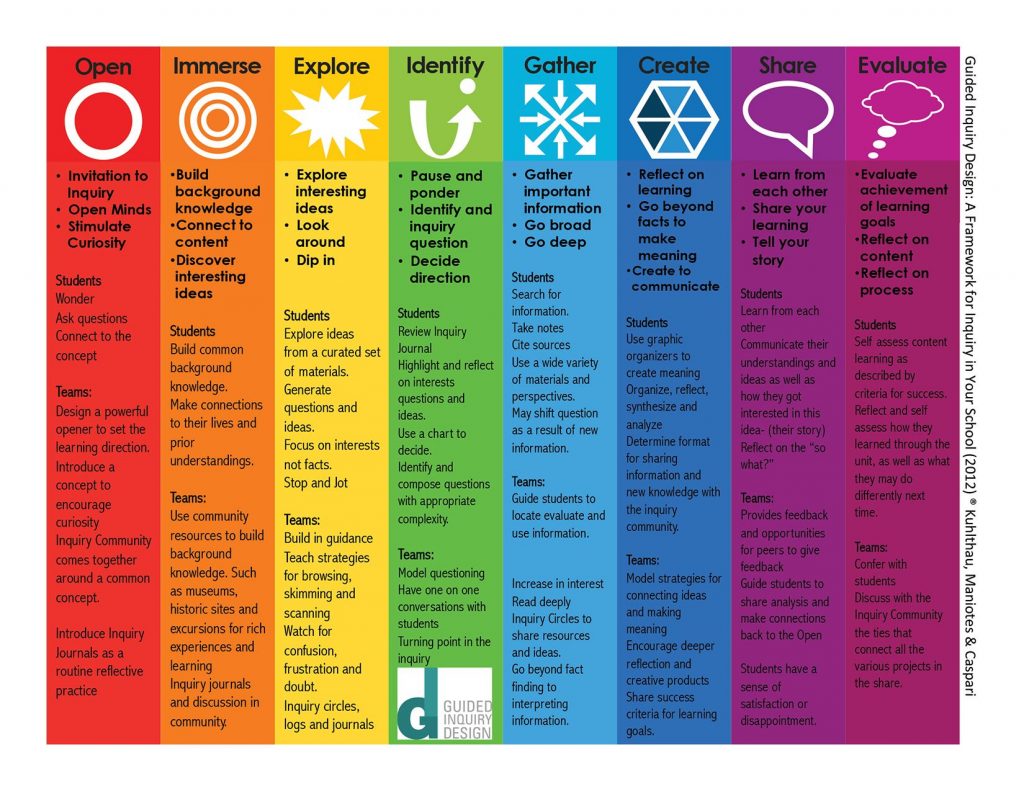

Yesterday I attempted to discuss this wiggly topic of how GID is not lockstep. In GID, our job is to guide students to find their own direction for inquiry in this fluid flexible process.
So, what are some key concepts that you can keep in mind as you try to follow the students and stay true to the process.
Maybe I’ve been hanging out with my 12 year old daughter and her slime too much, but it’s not a bad mental image for the difference between flexibility and rigidity. Slime vs Concrete

Being flexible takes deep understanding of the process. In order to deviate from the norm, we have to fully understand the norm, first. So knowing the process deeply from a theoretical standpoint and a practical “in the classroom” view helps us to be confident in our variations from that norm, to know what is in bounds and out of bounds. With that knowledge, we can balance trusting the phases of the process, with following the students as we get to know our students in the process.

Knowing the process phases and the intention of each phase help
s you to know when we are ready to move on. The bullet points for each phase are a great checklist for you. The more practice you have guiding the process with students, the more you know how it feels, how students interact, and what they need from you at each phase.
The more you understand the research behind GID, the more fluid and flexible you can become, in the moment. Here’s a link to some of the core research on the ISP – remember it is a user-centered design, meaning it came out of a need to better the experience for students who were learning through information in school. It doesn’t come from another industry, but is focused in education and on student learning.
Too much adherence to the plan, you’ll get concrete – and less learning. Inquiry learning requires us to Listen to our students, where they are struggling, where they are becoming inspired, in what direction they are leaning, will help you to “go with the flow” within the process.
In Guided Inquiry Design the learning team designs and plans activities that support students to accomplish each phase. Having an inquiry stance or mindset is critical to your flexible use of the GID process. Your inquiry stance is evidenced as you
The results of those observations and interactions takes the form of shifting and differentiating conversations, groupings, lessons, and directions as needed by students. That’s how we become flexible within the model, by paying attention to how our students are engaging.
The Inquiry Tools inform you of students’ needs. The example I described yesterday shows when you put in the work at each phase, you can be confident of your forward motion. In this case, the students had spent ample time in Open and Immerse and at the end of Explore they each had detailed their own individual ideas for the direction of their research all mapped out. Proper use of the Inquiry Tools will help to guide you and the process in flexible forward motion.
Conversations with your colleagues, coaches, and teammates can also help you to think through where you are and what students might need as compared to what was originally planned. Just going through the motions of your plans won’t help you to be flexible within the model, that might even solidify the flexible process into a lock step (concrete) approach. But reflecting on each phase, how the students engaged, and the intention of each phase can drive your flexibility within the process.
With that, I invite you to join us with your reflection here on this blog. That’s what this blog is for. It’s for you to have a space to reflect within our community and with my support! Because Guided Inquiry is better through reflective practice we created this space for you to practice, try and reflect. Here we are not looking for perfection, but an inquiry stance, that you’ve tried something and are learning from each attempt! Through you we can all learn and improve. Thanks for reading and I hope you’ll give it a go.
Leslie Maniotes, PhD ( leslie@guidedinquirydesign.com )
Author/Professional Developer for Guided Inquiry Design